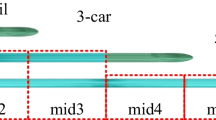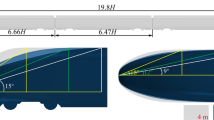Abstract
The aerodynamic performance of a maglev (magnetic levitation) train (MT) passing through a two-sided noise barrier was simulated by the improved delayed detached eddy simulations. The influence of the presence of noise barrier on both sides on the flow field around the MT and the pressure field in the noise barrier area are analyzed. The effect of changes of the noise barrier height and the centre of track (COT) distance parameter on its flow field were also studied. Numerical simulation results were verified by the moving model test. The results show that the noise barrier increases the pressure in the area around a train. The maximum pressure changes most as the tip of the head of the MT passes through the measuring point. The maximum positive and negative pressure amplitudes of the head wave on the inner wall surface of the noise barrier are increased by 83.5% and 58.4% compared to those the same height position measurement point in open air. On the inner wall of the barrier, the fluctuation of the pressure decreases with the increased height of the probe, which is opposite to the trend on the outer wall. Inside the noise barrier, the wind velocity in the x-direction is greater than that in open air when the tip of the nose and tail of the car passes. But the velocity in the y-direction when the tip of the head and tail cars passes is limited, and two speed peaks appear in the horizontal direction train induced wind. The higher the noise barrier, the higher pressure of the same height measurement point in the noise barrier area. Due to the passage of the train, the top of the noise barrier has a certain vorticity at the position of the head car and the tail car. Changing the height of the noise barrier changes how the vortex structure at the tail of the train develops. Moving the noise barrier further from the COT causes the fluctuations at the pressure measurement point inside the noise barrier to diminish meaning the pressure enhancement effect caused by the height of the noise barrier also diminishes.


























Similar content being viewed by others
References
Baker, C.: The flow around high speed trains. J. Wind Eng. Ind. Aerodyn. 98(6–7), 277–298 (2010)
Baker, C.J.: A review of train aerodynamics part 2—applications. Aeronaut. J. 118(1202), 345–382 (2014a)
Baker, C.J.: A review of train aerodynamics part 1—fundamentals. Aeronaut. J. 118(1201), 201–228 (2014b)
Baker, C.J., Jordan, S., Gilbert, T., Quinn, A., Sterling, M., Johnson, T., Lane, J.: Transient aerodynamic pressures and forces on trackside and overhead structures due to passing trains. Part 1 Model scale experiments. Part 2 Standards applications Proc IMechE Part F. J. Rail Rapid Transit 228(1), 37–70 (2014)
Bell, J.R., Burton, D., Thompson, M.C., et al.: Moving model analysis of the slipstream and wake of a high-speed train. J. Wind Eng. Ind. Aerodyn. 136, 127–137 (2015)
CEN European Standard.: Railway applications–aerodynamics. In: Part 4: Requirements and Test Procedure for Aerodynamics on Open Track. CEN EN14067–4 (2013)
Chen, G., Li, X., Liu, Z., et al.: Dynamic analysis of the effect of nose length on train aerodynamic performance. J. Wind Eng. Ind. Aerodyn. 184, 198–208 (2019)
Gilbert, T., Baker, C.J., Quinn, A.D.: Aerodynamic pressures around high-speed trains: the transition from unconfined to enclosed spaces. Proc. Inst. Mech. Eng. Part F J. Rail Rapid 227(6), 608–621 (2013a). https://doi.org/10.1177/0954409713494947
Gilbert, T., Baker, C.J., Quinn, A.D.: Gusts caused by high speed trains in confined spaces and tunnels. J. Wind Eng. Ind. Aerodyn. 121, 39–48 (2013b). https://doi.org/10.1016/j.jweia.2013.07.015
Lee, H., Kim, K., Lee, J.: Review of maglev train technologies. IEEE Trans. Magn. 42(7), 1917–1925 (2006)
Li, X., Chen, G., Wang, Z., et al.: Dynamic analysis of the flow fields around single- and double-unit trains. J. Wind Eng. Ind. Aerodyn. 188, 136–150 (2019)
Lü, M., Li, Q., Ning, Z., et al.: Study on the aerodynamic load characteristic of noise reduction barrier on high-speed railway. J. Wind Eng. Ind. Aerodyn. 176, 254–262 (2018)
Mao, B., Huang, R., Jia, S.: Potential applications of maglev railway technology in China. J. Transp. Syst. Eng. Inf. Technol. 8(1), 29–39 (2008)
Morden, J.A., Hemida, H., Baker, C.J.: Comparison of RANS and detached eddy simulation results to wind-tunnel data for the surface pressures upon a class 43 high-speed train. J. Fluids Eng. 137(4), 041108 (2015)
Muld, T.W., Efraimsson, G., Henningson, D.S.: Mode decomposition on surface-mounted cube. Flow Turbul. Combust. 88(3), 279–310 (2012)
Muld, T.W., Efraimsson, G., Henningson, D.S.: Wake characteristics of high-speed trains with different lengths. Proc. Inst. Mech. Eng. Part F: J. Rail Rapid Transit 228(4), 333–342 (2013)
Munoz-Paniagua, J., García, J., Lehugeur, B.: Evaluation of RANS, SAS and IDDES models for the simulation of the flow around a high-speed train subjected to crosswind. J. Wind Eng. Ind. Aerodyn. 171, 50–66 (2017)
Niu, J.Q., Zhou, D., Liang, X.F.: Numerical simulation of the effects of obstacle deflectors on the aerodynamic performance of stationary high-speed trains at two yaw angles. Proc. Inst. Mech. Eng. Part F J. Rail Rapid Transit 232, 913–927 (2017)
Rocchi, D., Tomasini, G., Schito, P., et al.: Wind effects induced by high speed train pass-by in open air. J. Wind Eng. Ind. Aerodyn. 173, 279–288 (2018)
Shur, M.L., Spalart, P.R., Strelets, M.K., Travin, A.K.: A hybrid RANS-LES approach with delayed-DES and wall-modelled LES capabilities. Int. J. Heat Fluid Flow 29, 1638–1649 (2008)
Soper, D., Gillmeier, S., Baker, C., Morgan, T., Vojnovic, L.: Aerodynamic forces on railway acoustic barriers. J. Wind Eng. Ind. Aerodyn. 19, 266–278 (2019). https://doi.org/10.1016/j.jweia.2019.06.009
Spalart, P.R., Deck, S., Shur, M.L., Squires, K.D., Strelets, M.K., Travin, A.K.: A new version of detached-eddy simulation, resistant to ambiguous grid densities. Theor. Comput. Fluid Dyn. 20, 181–195 (2006)
Wang, S., Bell, J.R., Burton, D., et al.: The performance of different turbulence models (URANS, SAS and DES) for predicting high-speed train slipstream. J. Wind Eng. Ind. Aerodyn. 165, 46–57 (2017)
Wang, J., Minelli, G., Dong, T., et al.: The effect of bogie fairings on the slipstream and wake flow of a high-speed train. An IDDES study. J. Wind Eng. Ind. Aerodyn. 191, 183–202 (2019)
Xia, C., Wang, H., Shan, X., et al.: Effects of ground configurations on the slipstream and near wake of a high-speed train. J. Wind Eng. Ind. Aerodyn. 168, 177–189 (2017)
Xiong, X., Li, A., Liang, X., et al.: Field study on high-speed train induced fluctuating pressure on a bridge noise barrier. J. Wind Eng. Ind. Aerodyn. 177, 157–166 (2018)
Yang, Q., Song, J., Yang, G.: A moving model rig with a scale ratio of 1/8 for high speed train aerodynamics. J. Wind Eng. Ind. Aerodyn. 152, 50–58 (2016)
Yau, J.D.: Aerodynamic vibrations of a maglev vehicle running on flexible guideways under oncoming wind actions. J. Noise Vib. 329(10), 1743–1759 (2010)
Yuan, H., Zhou, D., Meng, S.: Study of the unsteady aerodynamic performance of an inter-city train passing through a station in a tunnel. Tunn. Undergr. Space Technol. 86, 1–9 (2019)
Zhou, D., Tian, H.Q., Zhang, J., Yang, M.Z.: Pressure transients induced by a high speed train passing through a station. J. Wind Eng. Ind. Aerodyn. 135, 1–9 (2014)
Zhou, Z., Xia, C., Shan, X., et al.: The impact of bogie sections on the wake dynamics of a high-speed train. Flow Turbul. Combust. 104, 89–113 (2019)
Acknowledgements
The authors acknowledge the computing resources provided by the High-Speed Train Research Centre of Central South University, China. This work was supported by the National Key R&D Program of China (Grant No. 2016YFB1200601-B14).
Author information
Authors and Affiliations
Corresponding author
Ethics declarations
Conflict of interest
The authors declare that they have no conflict of interest.
Rights and permissions
About this article
Cite this article
Luo, C., Zhou, D., Chen, G. et al. Aerodynamic Effects as a Maglev Train Passes Through a Noise Barrier. Flow Turbulence Combust 105, 761–785 (2020). https://doi.org/10.1007/s10494-020-00162-w
Received:
Accepted:
Published:
Issue Date:
DOI: https://doi.org/10.1007/s10494-020-00162-w




